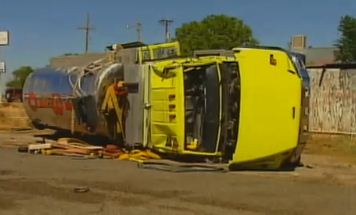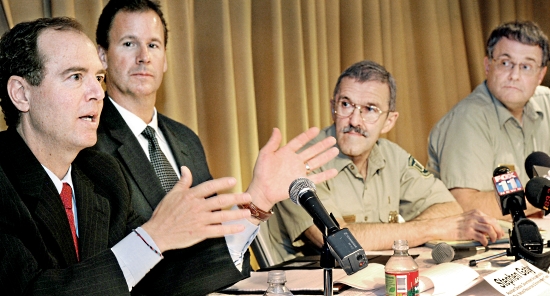The Whittier Daily News has an interesting account of yesterday’s forum hosted by Congressman Adam Schiff about the management of the 2009 Station fire that burned 160,000 acres near Los Angeles.
ALTADENA – Foothill residents left a community forum on the Station Fire with few questions answered and little confidence on Thursday, after Forest Service officials gave scant details as to how properties will be protected in the event of another devastating wildland blaze.
Rep. Adam Schiff, D-Pasadena, moderated Thursday’s forum on the mismanagement of the Station Fire, the largest wildland fire in Los Angeles County history.
Forest Service officials, as well a representative from the Congressional Government Accountability Office, tried to allay fears of a possible repeat of the 250-square-mile blaze that killed two Los Angeles County Firefighters and destroyed dozens of homes.
Homeowners, many of whom watched their houses burn in the Station Fire, weren’t convinced that much has changed.
“We are not safer,” said Rod Driscoll, whose Vogel Flats home was destroyed in the Station Fire. “We are going to be in the same situation this year in the area to the east that didn’t burn in the Station Fire.”
Forest Service officials were also criticized for not providing straight answers to the residents at the forum.
“I feel like some of these generalizations that you are giving, aren’t answering the questions these people are addressing,” said Sandra Thomas, Altadena Town councilwoman.
Tom Harbour, Forest Service director of aviation and fire management, spoke about the improved communications between agencies and the commitment to protecting property and lives in the event of another fire.
Harbour’s words fell short of comforting the audience.
“I got out of there with my car, my clothes on my back and my cat,” said Duncan Baird, retired battalion chief from the Pasadena Fire Department, who lost his Tujunga Canyon home in the blaze.
The Forest Service launched a feasibility study to examine the use of night-time helicopter water drops. The tactic was prohibited by the Forest Service during the Station Fire despite the proven effectiveness of Los Angeles County Fire helicopters in fighting fires from the air after dark, Harbour told the audience at the Altadena Library on Thursday.
Meanwhile, the Forest Service entered into an agreement with Los Angeles County Fire to conduct nighttime air operations upon request, Harbour said.
“We are in the night flying business right now with the helicopters being supplied by Los Angeles County,” Harbour said.
But limitations in the equipment could curb the volume of night flights.
Harbour told the audience that operating the helicopters on consecutive shifts with separate flight crews could “wear out” the helicopters.
Harbour’s comments set off groans and one man yelled: “In other words nothing has changed.”
“We are going to wear out our aircraft,” said Laura Olhasso, in a rare moment of sarcasm during the meeting. “That’s less than confidence-inspiring.”
Olhasso, a councilwoman in La Canada-Flintridge, harshly criticized federal officials for not releasing information from the investigation into the Station Fire some 20 months after the disaster struck.
“I am dismayed by the pace of the inquiry,” she said.
The GAO agreed to investigate the management of the Station Fire in 2010. After seven months of inquiry, Stephen Gaty, the agency’s assistant director of natural resources, declined to comment on the initial findings from the federal probe and told the audience the report won’t be released until late 2011.
While Harbour promised the residents that the Forest Service would throw all available resources at a fire, he noted that air operations are “expensive.”
Those comments also elicited groans from the crowd, some of whom openly wondered how much a lack of funds played into the grounding of aircraft during the early stages of the Station Fire.
“If those early decisions were made because of money, I ask you not to make that decision again,” said John Grancich, of Millard Canyon.
Written by Brian Charles
The Montrose Patch also wrote an article about the forum. Here is an excerpt:
Duncan Baird, a homeowner in the Big Tujunga Canyon area, where several dozen homes were lost, echoed the complaint of many that the Forest Service did not try to protect the area in the 48 hours after the blaze started on Thursday August 27, 2009. The Big Tujunga Canyon residents lost their homes on Saturday.
“There was a period of time all day Thursday and all day Friday when some serious mitigation could have been done with an aerial assault to pre-treat fuels in our canyon,” Baird said. “As it turned out there was absolutely zero work done in the canyon before the fire took our homes and everything we owned. ”
Baird and others questioned whether the Forest Service calculated whether saving their property would be worth the cost of deploying additional fire resources.
Harbour defended the agency’s response as being an”aggressive, assertive initial attack.”
He said cost factors are not considered when trying to put out a fire.
“We are not constrained by cost…we want to get the fire out. There is, hopefully, no question about that,” Harbour said.
Found another version of what happened at the forum, this time an article by Paul Pringle of the LA Times.







